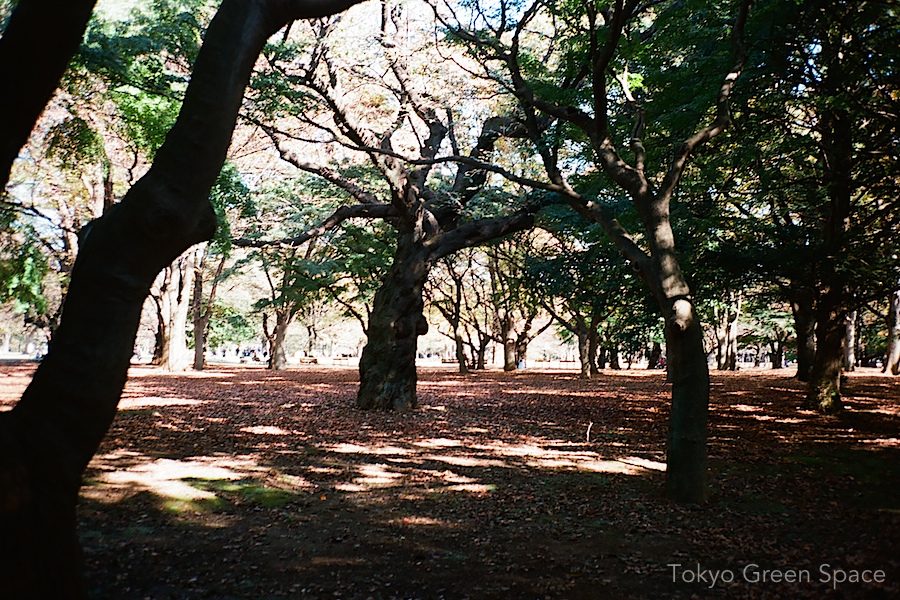
代々木公園なのに、影が多いの小さな森みたいでしょうか。
At Yoyogi park.

I love this path that starts at Shinjuku Dori, near the department stores, cuts between Kabukicho and Golden Gai, and ends up at the start of the male host zone in eastern Shinjuku. I wish all my city walking could be done on this narrow green path with mature trees.


路地からこぼれ出ているカシワバアジサイという花がきれいです。夏に咲いていますが、もともと東南アメリカの森から来ました。普通のアジサイのより、葉も花も違います。東京の建物の森で、この植物は自分のふるさとを思い出すでしょうか?
I love this late blooming summer hydrangea with white flowers spilling from the side street onto the main road near our place. It’s called “Oakleaf hydrangea” or kashiwaba ajisai in Japanese. It’s native to hardwood forests in the southeastern United States. In addition to distinctive leaves, it’s one of the few hydrangeas with cone-shaped flower bunches. Maybe built-up Tokyo reminds this bush of its native forest.

I like the city backdrop to my balcony green curtain. The rose and jasmine are the first to bloom.

先月友だちと海の森でボランティア植林に参加しました。二時間以内で、二十人が五百の木を植えました。この新しい都市の森はすばらしいと思います。五十万木はごみの上で育ちます。たくさんの都民はこの大掛かりなプロジェクトをまだ知りませんでした。
Last month some friends and I participated in a volunteer tree-planting at Umi no Mori, a forest being created on a landfill island on the bay. I’ve written before how few Tokyo residents know about this ambitious project promoted during Tokyo’s failed second Olympic bid in 2007. Umi no Mori is meant to carry cool ocean breezes into Tokyo’s crowded urban core.
The tree planting was fun. We were in a group of twenty or so volunteers planting 500 trees in a 25 square meter section. There were about 25 varieties of trees, and we planted them very close together. I learned from one of the volunteer leaders that this dense planting encourages the trees to compete and grow faster than normal. One of the volunteers explained to me that this is part of Miyawaki Akira’s method for restoring forests on post-industrial greenfields.
Creating new waterfront parks and planting 500,000 trees is certainly a great thing for Tokyo. Still, I wonder if this project were less top-down and more open to the citizens what greater impacts this project could have:
1. By encouraging more people to participate in the creation of the park, it would be a great chance to explain to Tokyo citizens about native trees and habitats. It would be awesome to link planting new trees in the Tokyo Bay with also adding greenery in every Tokyo neighborhood, with active participation by city residents.
2. By opening even a small section now, more people can begin to experience the park and perhaps learn more about urban garbage. What precisely is being put into this landfill? How do the layers of garbage reflect our contemporary lifestyles? What can be done to reduce the amount of garbage that must be buried?
I think this park will eventually be fantastic. However, it’s a missed opportunity not to make its creation more participatory, more transparent, more public, more connected to the rest of the city, more educational, and a catalyst for public and collective rethinking of the urban environment and waste production.


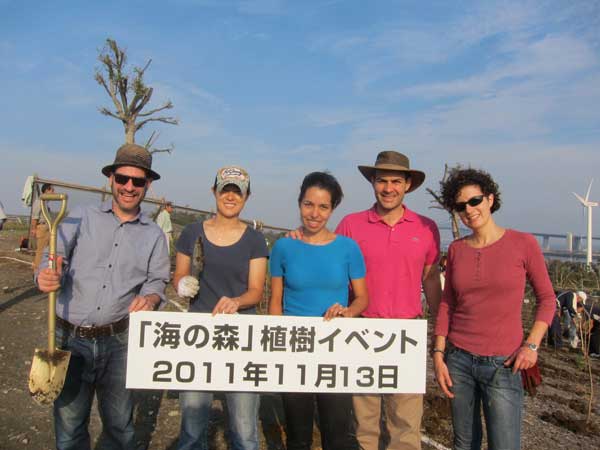
Ambassador Cedeno of Costa Rica and his wife Tauli, and Edoble’s Jess Mantell and her friend Miho participated with me.
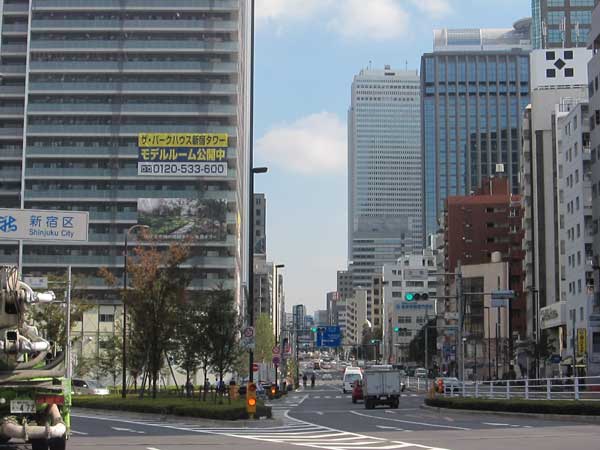
最近、贅沢な不動産開発が自然のイメージを広告に使っています。広告の中の田舎の森や現場から離れた風景を見ていると妙な 気持ちになります。本当の都市の森を作れば、不動産の価格はもっと上がります。西新宿で都市の森はどんな風に見えるだろう。
I’ve noticed recently more and more real estate advertising at construction sites and at recently completed buildings that show images of forests or famous urban landscapes that are nowhere near the location. A new luxury development rising at Jingumae 3 chome #37, the site of the former Harajuku Danchi, shows a photo of the ginko trees turning yellow on Icho Namaiki (いちょう並木).
Above is Nishi Shinjuku, which has several new office towers and new apartments on Ome Kaido, towards Nakano Sakaue. Following regulations, these buildings have planted street trees. But it is comical to see the image of a path meandering through a forest that’s half way up the new apartment building.
On the one hand, it’s good to see city people still dream of forests. On the other hand, these wealthy developers and the City of Tokyo regulators could increase the value of their properties by actually turning this marketing image into a reality.
What could an urban forest look like at this intersection?

渋谷のビルの上に、小さな森があります。宮下公園の斜め前にあって、このビルには店とギャラリーと事務所が入っています。こんなに木が見えて、自然光を使っている事務所は良さそうです。明治通りからは、この小さな空の森が見えませんが、渋谷のBear Pondコーヒーからはよく見えます。
Recently I have been drinking coffee at Bear Pond on the street that connects Miyashita Park and Aoyama. On these hot days, it’s great to look up and see a vertical forest on this 10 story mid-rise that combines retail, gallery, and office space. It’s easy to miss this from Meiji Dori, but you can see it easily from the Bear Pond coffee shop. it must be great to work surrounded by thick trees and natural light. It also looks like you can walk between the top three levels.

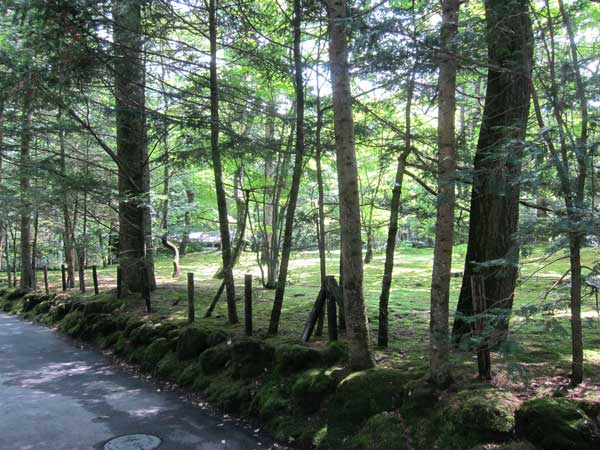
夏の軽井沢は涼しいです。自転車でまわって、苔の森や小川や池を見ました。東京から日帰りでも楽しいです。ジョンレノンとヨーコオノがよくたずねた喫茶店を見つけました。
In the heat of summer, Karuizawa remains cool and elegant. We found a moss forest, streams, and a small lake. It is just an hour from Tokyo by bullet train, and easy to rent a bike near the station. We passed many tennis courts, but did not meet any royalty. By accident, we met the charming proprietress of a coffee shop frequented by John Lennon and Yoko Ono in 1977.

節電のために、この夏は東京のどこでもグリーン・ウォール「垂直の庭」が作られています。混雑して、背が高い都市では、垂直の表面のほうが屋根より多いです。まず、杉並区役所とマンションのベランダでグリーン・カーテンが作られました。今、事務所や店の建物で、グリーン・ウォ―ルを作りはじめました。夏にグリーン・カーテンはヒートアイランド現象の緩和のために良くて、一年中、グーリン・ウォールは庭や農園や生息地を提供します。この写真を芝公園、新宿御苑前、大井町、大門で撮りました。
Spurred by the energy crisis post-Fukushima, there’s been a notable increase in the number of mid-rise office and retail buildings with green walls. In an over-built city, vertical surfaces are the largest potential area for gardening, farming, and habitat creation.
Tokyo has far more vertical surfaces than roof areas, and we are only at the very beginning of creating an urban forest.
I have been following this topic for a while, and have watched this idea spread from notable public spaces like Suginami’s ward office (world’s largest green curtain) to apartment balconies, flower shops, and now commercial and retail spaces. This wide distribution across Tokyo and across building types is very exciting to see.
Some questions I have include:
The answers will come from experimentation and diffusion. The photos, from top to bottom, are four green walls I’ve recently seen:
1. Hasegawa Green Building in Shiba Koen
2. Office mid-rise in Shinjuku Gyoen-mae (2 photos). The company that created and maintains this green wall is called Ishikatsu Exterior (石勝イクステリア).
3. Oimachi retail building near station.
4. Daimon office building.





東京農業大学の鈴木先生は東京の中学校でホタルの生息地を作る予定です。毎夏、先生と中学生は群馬県に行って、ホタルを観察して勉強します。今回、私も招待されました。
ホタルにはきれいな水と暗闇が必要です。鈴木先生によると、都市の生息地には社会的なデザインも要ります。学校のとなりのお寺や退職をした方たちのセンターも参加できます。
川場村に来て、中学生たちは田んぼの草むしりをして、小さい川でカニとカエルを観察しました。都市の子供なのに、中学生たちは本当に勇気があります。
夜に、ゲンジボタルとヘイケボタルを見ました。林と田んぼのそばにはホタルがいっぱいいます。
「なかのビレジ」というホテルに泊まりました。内側は和風モダンで、外側は山の一部 みたいです。湯名な坂倉建築研究所はホテルを作りました。
川場村では、たくさんリンゴが育っています。最近、ブルーベリーも育っています。
Tokyo University of Agriculture Professor Suzuki is planning a firefly habitat at a junior high school. Each year, teachers and students from the Tokyo school visit Gunma to study fireflies. This year I was also invited.
Fireflies need clean water and darkness. According to Professor Suzuki, creating habitat in the city also requires a “social design.” The temple, cemetary, and senior center near the school are also invited to participate.
When we arrived at Kawaba-mura, the school girls weeded a rice field and played with frogs and crabs in the creek. Even though they are city kids, the students are very brave.
At night, we saw Genji fireflies and Heiki fireflies. There are a lot of fireflies on the edge between the forest and the rice field.
We stayed at a hotel called “Nakano Village” which on the inside is Japanese modern style, and on the outside the building looks like part of the hillside. It was designed by the famous Sakakura Associates.
Kawaba mura has many apple orchards, and recently they are also growing blueberries.
The trip made me think of the following:
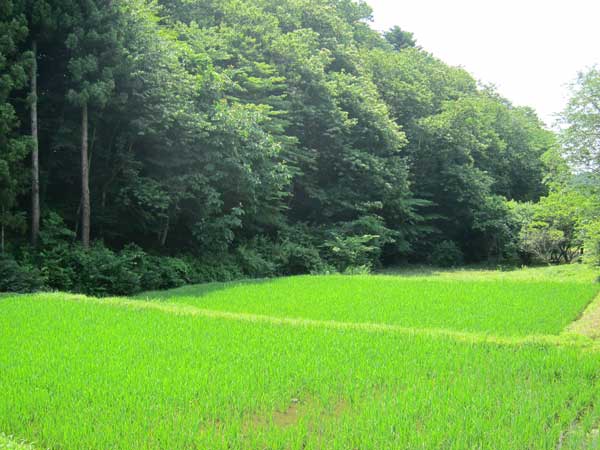



Miniature pine forest outside Japan Supreme Court. In 1970s, traditional garden joined Brutalist architecture. Would love to see traditional garden with urban forest today.
最高裁判所の外にすてきな松の小さな森がある。70年代に日本庭園とブルータリスム建築は一緒になった。将来は日本庭園と都市の森は一緒になれるかな。
Walking in Chiyoda-ku opposite the Imperial Palace, I saw this forest of beautiful stunted pine trees above a stone wall. At eye level, there appear to be hundreds of carefully twisted pines whose canopy is less than one meter from the ground. Behind this gorgeous sea of needles is the Supreme Court of Japan (最高裁判所), a 1974 Brutalist concrete building that won awards for its architect Shinichi Okada.
I love the stone wall and the pine forest. In my dream, the once avant-guarde building could regain its ぷprominence by using the concrete structure to support a dense urban forest on its walls and roof. The wildness of the forest hill would contrast nicely with the austere pine forest serving as a formal moat to this newly enlivened public building. The contrast would be magnificent.
While I love the chaos of DIY gardens and the lushness of urban forests, there is also room for traditional Japanese gardens and techniques in the urban landscape, particularly around important public buildings. The contrast between heavily manipulated and more natural landscapes is a new concept at which Tokyo can excel.

Frequently I hear from urban planners, professors, students, and green city people from around the world who want to share their projects or meet people in my network. I encourage them to create a guest blog post. Below is a French student project that turns urban or rural nature discovery into a video game. It sounds creative and fun! The makers will be at Tokyo’s Miraikan this week to talk about it. And, if you would like to share your project, please send in a guest blog post! [Editor]

Can nature be the playground of a video game? Interested in this idea, five students in digital design and production from Gobelins, l’école de l’image, Paris, worked for nine months on a common graduation project named úti (Icelandic for “outdoor”). By addressing the discovery of nature using a game, the team, composed of three graphic designers and two developers, wishes to approach a young audience.
The concept is simple: put in the shoes of a explorer, the player starts exploring the nature that surrounds him, be it a green space downtown, or a forest in the countryside.
The game is composed of a mobile application, which uses GPS to record the walking path and provide the player with contextual activities: discover nearby points of interest, identify tree species, take part in collaborative timelapse animations by taking photos…
Back home, the player can visualize the territory he explored and the species he identified, by connecting to his base camp on úti website.

úti will be showcased at the Digital Content Expo, in the Miraikan, from tomorrow to Sunday. You will be able to test the mobile application and meet the team at the “Futur en Seine” stand (1F).
They are looking for partners and investors, so if you are interested in supporting the project, please contact the team at contact@projet-uti.com
More info on the Digital Content Expo website: http://www.dcexpo.jp/en/programs/futurenseine/
Visit úti website for video demos: http://www.projet-uti.com